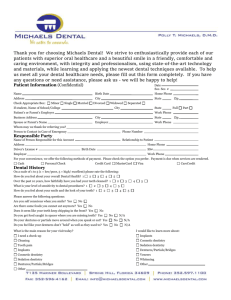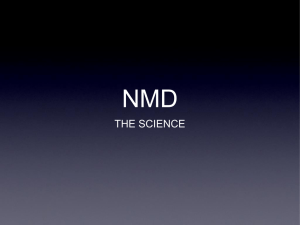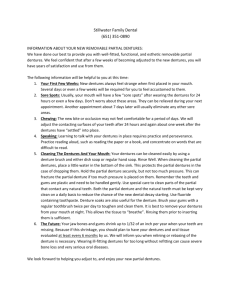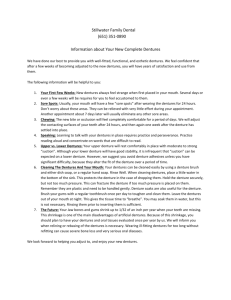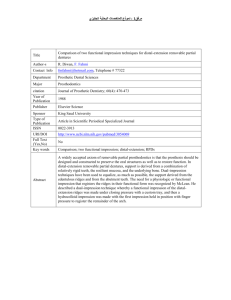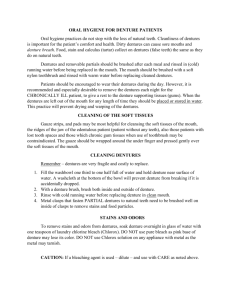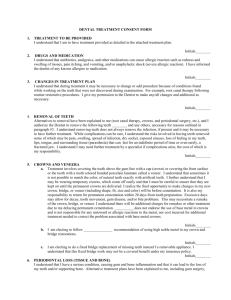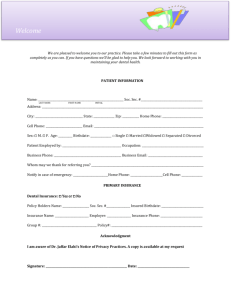Pytannya_PMK_5_modul_5_kurs_eng
advertisement
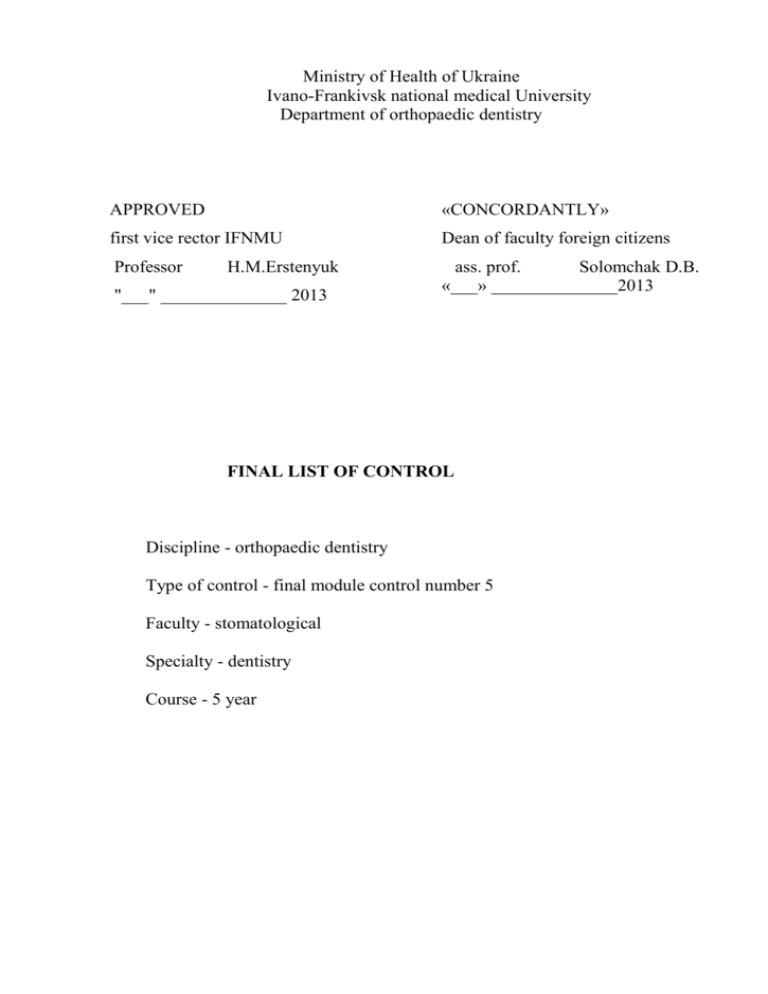
Ministry of Health of Ukraine Ivano-Frankivsk national medical University Department of orthopaedic dentistry APPROVED «CONCORDANTLY» first vice rector IFNMU Dean of faculty foreign citizens Professor ass. prof. Solomchak D.B. «___» ______________2013 H.M.Erstenyuk "___" ______________ 2013 FINAL LIST OF CONTROL Discipline - orthopaedic dentistry Type of control - final module control number 5 Faculty - stomatological Specialty - dentistry Course - 5 year List of final control (final module control) is made : based on standard curriculum for students of Faculty of Dentistry Department of Orthopaedic Dentistry for the professional direction 7.12010005 - "Dentistry " from 2013 The list of questions approved at the meeting of the Department of Orthopaedic Dentistry protocol № 3 from 23.10. 2013. Head of Department, MD, Professor. _______________ Ozhohan Z.R Checklist reviewed and approved by methodic Commission on Dental subjects IFNMU. Protocol № 3 from 05.11.2013 Head of cyclic commission, MD, Professor. ______________ Ozhohan ZR (signed) 1. Orthopedic dentistry. Determination of the discipline, its purpose, objectives. The main directions of development of science. The contribution of the department in the development of orthopedic dentistry. 2. Diagnosis of orthopedic dentistry. Methods of examination the patient diagnosis parts (causative, functional, anatomical). 3. Method of examination of patient in orthopedic dentistry clinical. History of the disease. 4. Features collecting history of examination the patient. 5. Instrumentation and special methods in orthopedic dentistry. 6. X-ray methods, techniques, information to establish a definitive diagnosis. 7. Electromyography, methods, information for diagnosis. 8. Gnathodynamometry. Backup and residual periodontal capacity practical importance. 9. Chewing force chewing pressure, chewing efficiency. Methods for their determination. 10. Static and dynamic methods for determining the efficiency of mastication. 11. Preparation of oral cavity to the dental prosthesis types of surgical, therapeutic, orthodontic) their scope and significance. 12. Classification of defects of dentition for A.I.Betelman, Kennedy. Their importance in clinic of orthopedic dentistry. 13. Bite. Physiological and pathological bite. Developmental characteristics of bite. 14. Mobility and suppleness of the oral mucosa. Classification and importance in removable prosthetics. 15. The structure of the oral mucosa. Its changes in dental prosthetics. 16. Marginal periodontium. Anatomy of periodontal connection. Structure, function and value. 17. Types of atrophy of the jaws. Factors that cause atrophy of the jaws and their clinical significance. 18. Anatomy of the upper and lower jaws and their functional features. 19. Masticatory system components and their functional interaction. 20. Groups of masticatory muscles and their functions. Phenomenon of consistent antagonism, synergism in the masticatory muscles. 21. Facial musculature and its functions. 22. Relative physiological rest of masticatory muscles and its clinical significance in orthopedic dentistry. 23. Neuro- muscular apparatus. Reflexes dentoalveolar system. The concept of periodontomuscular, gingivomuscular, miostatic reflexes. Their value. 24. Anatomical features of the temporomandibular joint. The main structural elements and their functional significance. 25. The mechanism of movement of the mandible. Comparison of anatomical and physiological mechanisms of masticatory system in different groups of animals. The relationship between shape and function of the temporomandibular joint. 26. Articulation. Movement of the mandible in the sagittal plane and transversal planes. The main parameters of these movements. 27. Movement of the mandible in the vertical, sagittal and transversal directions. Phases of chewing movements after Gizy. 28. The mechanism of movement of the mandible in the sagittal direction. Incisive and articular ways their relationship. Hrystensen phenomenon. The value in the design of complete dentures. 29. Movement of the mandible in transversal direction (Bennett angle, the ratio of dentition). 30. Sagittal and transversal occlusal curves, their importance in the design of artificial dentition in the manufacture of complete dentures. Working and balancing side (occlusions are characteristic of contacts). 31. Methods of recording (registration) jaw movements (intra oral, extraoral). 32. Biomechanics of jaw movements, its importance for the construction of dentures. Definitions " articulation ", " occlusion " and their significance for the construction of dentures. 33. The structure alignments. The concept of dental, alveolar and basal arch. Occlusal curves (Spee and Wilson). 34. Factors that ensure stability of the teeth. 35. Anatomy of the occlusal surfaces of the teeth and dentition. Occlusal contacts of teeth. 36. Factors of occlusion (articular way; Bennett movement, occlusal plane - Spee, Wilson, morphology occlusion, incisive way, the distance between the articular heads). 37. Structure and function of periodontal disease. Transformation of chewing pressure. 38. Structure and function of the periodontium. Mobility of teeth, diagnostic value. 39. Type of occlusion. Contacts teeth with central occlusion. Value anterior and molar teeth in the position of central occlusion. 40. Contacts teeth at promotion to the front of the lower jaw and its lateral movements. Premature contacts - supracontacts. 41. Summary of the theory of joint articulation of the mandible and its practical significance. 42. Summary of spherical articulation theory and its practical significance. 43. The theory of articulation balance, basic provisions. 44. Pain. Anesthesia. Methods of anesthesia in orthopedic dentistry. Medical and pharmacological agents for anesthesia. 45. Possible errors and complications of anesthesia (dizziness, collapse, anaphylaxis), clinical features, volume rendering first aid. 46. Asepsis and antisepsis in clinic of orthopedic dentistry. 47. Disinfection and sterilization of instruments and impressions. Preventing the spread of infectious diseases in the dental clinic. 48. Impressions and their classification. The materials used for their production. 49. Impression materials. Requirements. Characterization of thermoplastic impression materials, idications for their use. 50. Impression materials. Requirements. Characterization of elastic impression materials, indications for their use. 51. Impression materials. Requirements. Characteristics of silicone impression materials, indications for their use. 52. Complications in obtaining anatomical gypsum impressions and their prevention. 53. Classification of impression materials. Requirements that relate to impression materials. 54. Requirements for artificial crowns. Indications for covering the tooth by crown. Classification of crowns. The materials used for the manufacture of artificial crowns. 55. Implications of preparation of dental hard tissues. The need for the use of temporary structures. 56. Requirements for the svaged metal crowns. Types of making, materials, tools. 57. Terms preparation of various functional groups oriented teeth for svaged crowns. Toolkit. 58. Clinical and laboratory stages of manufacture svaged crowns. 59. Value of crown edge with marginal periodontal tissues. Complications of extended and shortened crown edge, morphological changes in the injury of marginal periodontium. 60. Plastic crown. Indications and contraindications to their use. 61. Clinical and laboratory stages of their production. Materials used for this purpose. 62. Combined crown. Clinical indications for their use. Terms preparation of teeth. Manufacturing methods and materials. 63. Casted crown. Indications. Clinical stages of manufacture. Materials for their wall. 64. Laboratory stages of casted crown fabrication. The mechanism of fixation of facing material. 65. Fixed partial dentures. Indications and contraindications for prosthetic dentition defects fixed partial dentures. 66. Biomechanics fixed partial dentures. Requirements for abutments. 67. Principles of design of fixed partial dentures. 68. Indications for the use of various support elements in fixed partial dentures. Structure of supporting elements. 69. Structures fixed partial dentures, indications for their use. 70. Comparison of solder, and non-soldered fixed partial dentures. 71. Clinical and laboratory stages of manufacture svaged-soldered fixed partial dentures. 72. Solders and fluxes. Silver solder, composition, method of application. The role of flux during soldering. 73. Metals and alloys used in orthopedic dentistry. Noble alloys. 74. Metals and alloys used in orthopedic dentistry. Steel and its brands. Physico- chemical properties. The role of alloying elements. 75. Clinical and laboratory stages of manufacturing of non-soldered fixed partial dentures. 76. Modeling of intermediate fixed partial dentures. Relationship between the shape and topography of dentition defect. 77. Factors that provide a fixing of dental prosthesis. Terms and sequence of fixation. 78. Types of fixing cements (phosphate, glass ionomer, carboxylate), the indications for their use. 79. Studies of patients with partial defects of dentition. 80. Anatomical and physiological characteristics of the oral cavity with partial loss of teeth. 81. Selection and justification designs of removable partial dentures with distal included and not limited to defects of dentition. 82. Impressions and their classification. Requirements for impressions. Getting impressions in the manufacture of removable partial dentures. 83. Methods of fixation of removable partial dentures. The role of biophysical and mechanical methods fortifications dentures. 84. Abutment teeth and their significance for fixing dentures. Klamerna line. Point, line and plane reinforcement of dentures. Choosing the anchor teeth. 85. Classification clasps. Ways clasps on dentures. 86. Value retention anatomical elements for fixation of removable partial dentures. Bezklamerni dentures. Indications for their use. 87. Identifying and fixing the central occlusion in groups I and II defects of dentition. 88. Identifying and fixing the central occlusion in Group III dentition defect. 89. Choosing the design of dental prostheses in the presence of a tooth on the upper and lower jaws. 90. Laboratory stages of fabrication of removable partial dentures. Materials used for this purpose. 91. Indications for fabrication of removable partial dentures with metal base. Clinical and laboratory stages of production. 92. Cast metal skeletons. Metal alloys. Compensation shrinkage metals. 93. Replacement of defects of dentition clasp dentures. Indications and contraindications for the manufacture of clasp dentures. Design elements clasp dentures and their significance. 94. Diagnostic models. Requirements, rule making. Planning design of clasp dentures. 95. Paralelometriya. The goal of the problem. Methods of paralelometriyi. Choosing the anchor teeth. 96. Stages of paralelometriyi. 97. Clasps. Indications for their use. Classification. Parts clasps. 98. She clasps system. Ways clasps with a framework. 99. Telescopic mount. Indications and contraindications for the manufacture of removable partial dentures with telescopic system of fixation. 100. Clinical and laboratory stages of manufacture of dentures with telescopic mounting system. 101. Attachments (locks, hinges). Classification. Indications for use. 102. Cast frames clasp dentures for refractory models. Duplication of models. Materials for duplication. 103. Preparing the models for duplication. 104. Compensation of shrinkage metals. Molding mass. Metal alloys for the manufacture of clasp dentures. 105. The shape, size and position of the arc clasp prosthesis to the upper and lower jaws, depending on the topography of dentition defect. 106. Fit frame clasp prosthesis. Requirements for solid frame. 107. Fixing and correction of clasp prosthesis. 108. The mechanism and timing of adaptation to removable partial dentures. Terms of removable partial dentures using. 109. Effect of dentures on oral tissues. Diagnosis, clinical features and treatment of prosthetic stomatitis. 110. Methods for setting teeth in removable partial prosthesis. 111. Factors that provide functional value of removable partial dentures. 112. Artificial teeth. Methods of manufacture and materials. Selection rules for the production of artificial teeth in dentures. 113. Terms of setting artificial teeth. Fixation in the base denture. 114. The compression extrusion of plastics. Materials and equipment. Methods of mounting models in the ditch, packaging plastic. 115. Packaging of plastics by pressing. Mounting of models in the ditch. The properties of plastics for packaging. 116. Steps of polymerization of plastics. Preparation of plastic for packaging. 117. Modes of polymerization. Insulation. 118. Materials used for making bases of removabledentures. Acrylic plastic. Composition, method of application. Positive and negative properties. 119. Assessment of quality of materials of polymerisation basis. Porosity, types, causes and solutions. 120. Research of the oral cavity in patients with totally edentulous jaws. 121. Classification of edentulous jaws. Morphological features of the structure toothless jaws to consider in making full dentures. 122. Classification of mucosal pliability of toothless jaws after Lyund, Supple). Value for selecting methods of obtaining impressions. 123. Anatomical features of edentulous jaws that are relevant for fixing removable dentures. 124. Classification of impressions for the manufacture of complete dentures (height of edges on the degree of mucosa pressure). Impression materials, their properties, indications for use. 125. The boundaries of prosthetic bed in the manufacture of complete dentures. " Valvular zone " of its topography. 126. Fixation, stabilization, balance full dentures, and factors that provide them. 127. Methods for obtaining functional impression of the edentulous jaws. Compression and decompression impressions. Justification of receiving them. 128. Methods of functional impression at Herbst. Functional tests, their clinical study. Fitting of individual trays after Herbst at the upper and lower jaw (functional tests). 129. Defining the central value of the jaws in the absence of teeth. 130. Rules and requirements for making wax pattern of the occlusal rollers. 131. Anatomical and anthropometric methods of determination of interalveolar height. 132. Anatomical and physiological method of determination interalveolar height (height of bite). 133. Devices that reproduce mandibular movements and their classification. 134. Imposing of full dentures. Adaptation. Rules and recommendations that the use of full dentures. 135. Implantation. Indications and contraindications for implantation. 136. Types of implants. Indications for use. 137. Single-stage implantation. Indications. Methods of surgical intervention. 138. Two-stage implantation. Indications. Methods of surgical intervention. List of practical skills to module 5 1. Examination of the patient. Set of preliminary and final diagnosis on the basis of examination (clinical and laboratory). 2. Make a plan for orthopedic treatment. 3. Make a plan to prepare the patient to oral prosthesis. 4. Get of anatomic impression of the upper and lower jaws. 5. Fix the central occlusion in group II defects. Identify and fix the central value of the jaws in Group III and Group IV defects. 6. Preparing of teeth for metal crown. 7. Preparing of teeth for casted crown. 8. Fit of artificial crowns. 9. Checking the designs of fixed partial dentures. 10. Fit of casted combined fixed partial dentures. 11. Fixing of crowns and fixed partial dentures. 12. Checking the design of partial and full dentures. 13. Hold the overlay of removable partial or complete dentures. 14. Correction of partial or complete dentures. 15. Rate diagnostic model in parallelometr and plan design of clasp denture on diagnostic models. 16. Fit the frame of clasp prosthesis. 17. Hold the fixing of clasp prosthesis. 18. Choosing designs of fixed partial dentures. 19. Prepare the tooth root for the manufacture of casted post abutment and conduct simulation abutment. 20. Conduct selective of teeth. 21. Alignment of occlusal curve using teeth polishing. 22. Occludogram. 23. Removal of crowns. 24. Prosthesis on implants.
